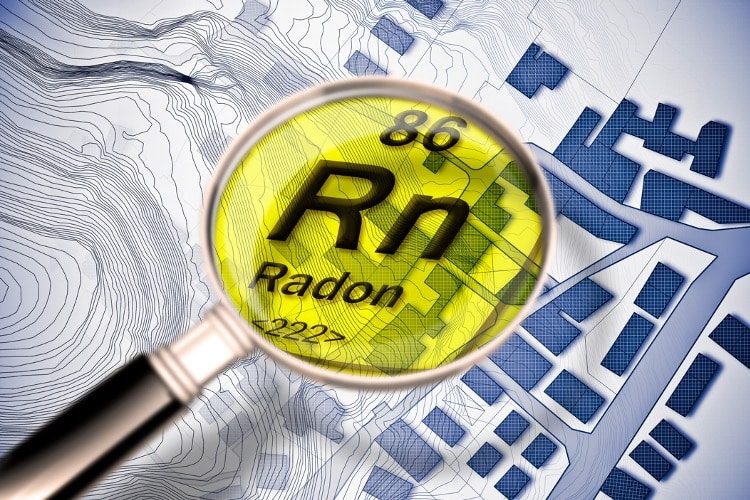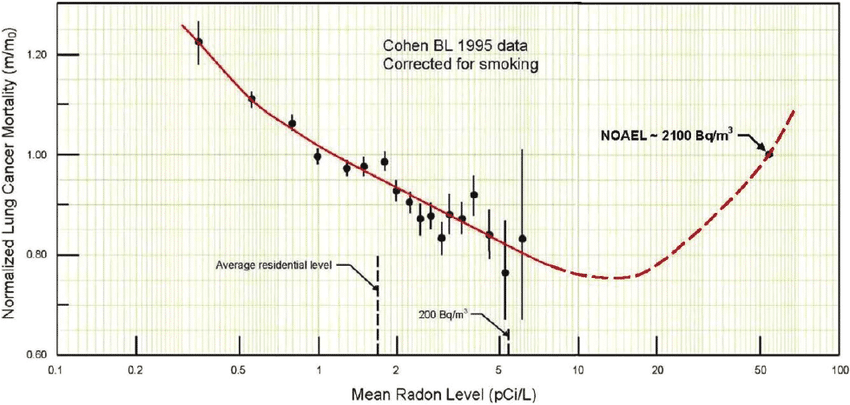
Radon has been around since long before mankind appeared on Earth. More than half of our natural background radiation exposure comes from radon, because it is a constituent of the air we breathe. (See here for more information about natural background radiation.)
If radon were as deadly as some would have us believe, mankind would have become extinct long ago.
The radon isotope of interest is radon-222 (Rn-222), which has a half-life of about 3.8 days. (Half-life is explained here.)
Radon radioactive decay byproducts emit both alpha particles and gamma rays. (Read about these forms of radiation here.) While radon itself is exhaled from our lungs with the air we breathe, it is the radioactive decay byproducts which remain in the lungs and produce the radiation dose to lung tissue.
In the low concentrations encountered in American homes, radon is not a cause of lung cancer, let alone “the second leading cause,” as claimed by the U.S. Environmental Protection Agency (EPA). On the contrary, in this setting radon is actually protective against lung cancer. Any attempt to reduce the concentration in homes lowers that protective feature, and leads to a greater, not lesser, probability of developing lung cancer.
If that sounds absurd, I would refer the reader to a study at Health Physics, Test of the Linear-No Threshold Theory of Radiation Carcinogenesis for Inhaled Radon Decay Products, conducted by University of Pittsburgh physics professor Bernard Cohen in the early 1990s. Dr. Cohen examined homes in more than 1,700 counties containing greater than 90 percent of the U.S. population. He had hoped to measure how quickly lung-cancer rates increase with higher home radon levels.
However, what he found was that there were lower lung-cancer rates in counties having higher average radon levels, and, conversely, higher lung-cancer rates in counties having lower average radon levels.
Because this was not the result he was anticipating, Dr. Cohen enlisted a statistician to find possible confounding influences, such as smoking or other carcinogens, that might explain this unexpected and very strong inverse relationship. After examining hundreds of possible confounder combinations, they were unable to identify an alternative explanation for the study findings as illustrated in the graphic below.

Although a number of scientists have repeatedly tried to refute Dr. Cohen’s study, they have been unable to assemble a plausible argument in opposition, and his discovery of radon’s protective (hormetic) effect at low levels of exposure has been corroborated by dozens of studies since then.
Despite this, regulatory agencies such as the EPA, whose administrators have a stake in maintaining the status quo, refuse to accept the study results. So do companies who profit from home radon remediation mandates.
Studies concluding that low doses of radiation are harmful either ignore biological reality or distort and/or dismiss it. The “all radiation is harmful” paradigm is a powerful hindrance to scientific objectivity. It was justifiably called “the greatest scientific scandal of the 20th century” by the former director of the Swedish Radiobiology Society, Gunnar Walinder, in his 1995 book Has Radiation Protection Become a Health Hazard?
It must be pointed out that the home radon remediation level of 4 picocuries per liter of air (pCi/L) is an arbitrary EPA limit that has nothing to do with biological health. As indicated in the graphic above, this radon level is well within the hormetic region and remediation measures will actually reduce the beneficial effects of home radon.
Regardless of the actual radon concentrations and associated radiation doses in American homes, any concern about the potential health effects of indoor radon should be based on actual observed effects. A report by the International Commission on Radiological Protection (ICRP Report 103, 2007) concludes that there is general agreement that epidemiological methods used for the estimation of cancer risk do not have the power to directly reveal cancer risks for doses up to approximately 100 millisieverts (mSv). (See here for an explanation of Sievert units.)
Since our annual natural background radiation exposure from radon is only about 2 mSv, there is no evidence to support any cancer risk estimates from home radon.
Editor’s Note: This article is the fifth in a continuing series published by The New American. For background material, please reference Dispelling Irrational Fear of Radiation, Understanding Radiation Risks & Benefits, The Dynamic World of Radioactive Decay, and Latest Low-dose Radiation Research Program a Retread?



